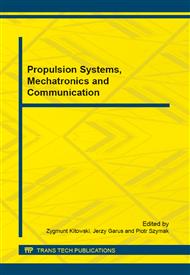p.223
p.234
p.245
p.253
p.261
p.271
p.279
p.289
p.299
The Ongoing Assessment of the Technical Condition of Avionic Hydraulic Drives on the Basis of Information Received from Means for Unbiased Flight Control of Aircrafts
Abstract:
During the ongoing operation of the hydraulic system you need a drive control information capable of maintaining fitness. Existing methods for assessing the technical condition of the hydraulic system require dismantling the hydraulic units and their research on test rigs. These methods are expensive, time consuming and do not provide a quick assessment of the technical condition. The aim of the study is to present the possibilities of using the evaluation of technical aviation hydraulic drive method which involves the use of objective information from the aircraft's flight control. In the proposed method, the carrier of information to the ongoing evaluation of the technical condition of the hydraulic system aviation as a whole is the pressure prevailing in it. With pressure and its features is inextricably bound up time. This relationship may be obtained directly from the objective flight control of the aircraft. The greatest credibility and the diagnostic value of two control parameters are obtained from the flight control objective. The first time the air pressure drop in the hydraulic drive from the top to the bottom of the measured value of the measured value after switching off the power unit. The second time the pressure falls below a certain value, and its return to the values of the movement during the hydraulic motor. The method enables the ongoing assessment of the technical condition of the hydraulic system is a fast and costless.
Info:
Periodical:
Pages:
261-270
Citation:
Online since:
January 2016
Authors:
Keywords:
Price:
Сopyright:
© 2016 Trans Tech Publications Ltd. All Rights Reserved
Share:
Citation:


